You’ve spent countless hours perfecting your jewelry design skills, but if you can’t effectively communicate with clients, even your most brilliant creations won’t reach their full potential. The difference between a satisfied customer and a raving fan often comes down to how well you understand their vision and guide them through the design journey. Most designers focus on technical expertise while overlooking the communication strategies that transform one-time buyers into lifelong advocates.
Understanding Client Needs Through Active Listening
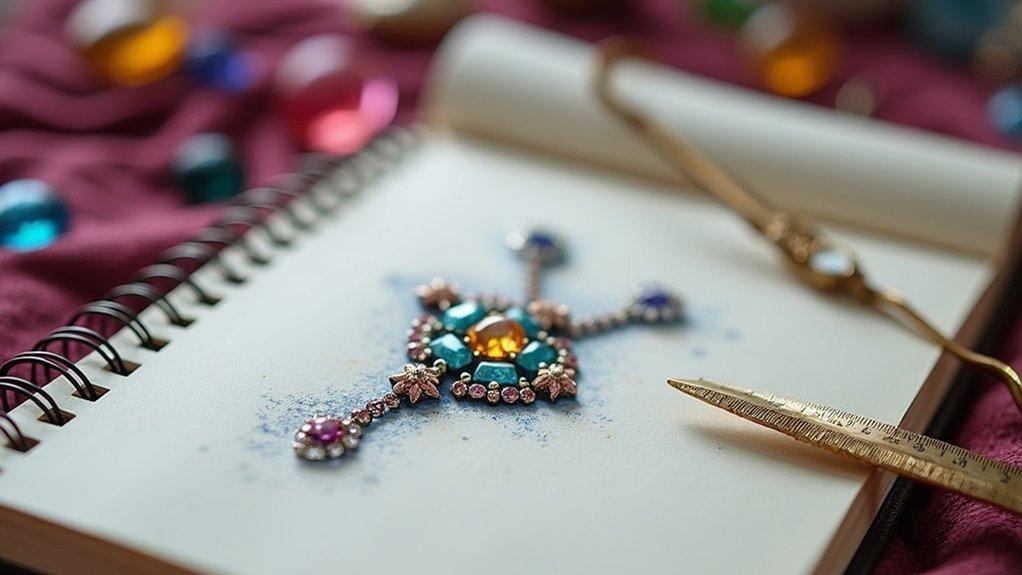
When clients enter your jewelry design studio, they’re often carrying more than just ideas—they bring emotions, memories, and dreams that aren’t always easy to express.
Active listening becomes your most powerful tool for uncovering these deeper meanings. You’ll need to go beyond simply hearing their words and start interpreting the emotions behind their requests.
Ask open-ended questions about their lifestyle, preferences, and the story behind their desired piece. Many clients won’t articulate their true desires initially, so patience during these conversations is essential.
Developing Visual Communication Strategies for Design Concepts
While words capture the emotional essence of a client’s vision, visual communication transforms abstract ideas into tangible concepts they can truly comprehend.
During client meetings, you’ll find that sketches, mood boards, and reference images create immediate clarity around jewelry design concepts. CAD renderings become your most powerful tool, allowing clients to examine their custom pieces from every angle and eliminate costly misunderstandings.
Visual tools like sketches and CAD renderings eliminate confusion, giving clients crystal-clear understanding of their custom jewelry before production begins.
Present lifestyle imagery showing how pieces look when worn—this helps clients make confident decisions.
Keep your communication flowing by sharing updated visuals throughout the design process, maintaining engagement and building trust.
Encourage clients to bring their own reference images of admired designs. This collaborative approach guarantees their preferences translate accurately into the final piece while streamlining your entire design workflow.
Building Trust During Initial Consultation Meetings
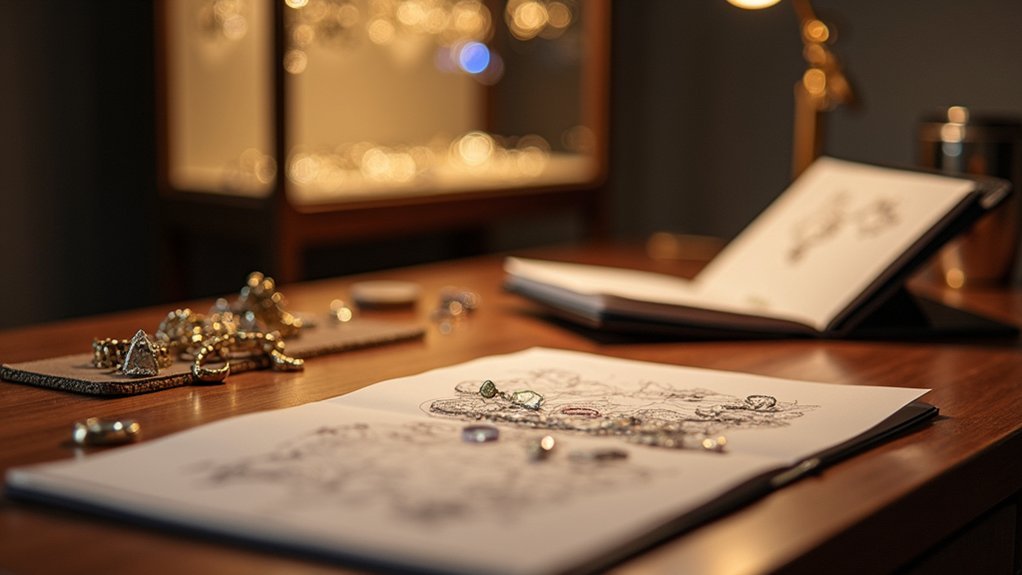
Your visual communication skills set the stage for success, but the foundation of any exceptional jewelry project begins with that first face-to-face meeting with your client.
Building trust starts immediately—you’ve got just seven seconds to make that vital first impression. Focus your customer service on active listening and asking open-ended questions to uncover their true desires.
Demonstrate your expertise by clearly explaining design concepts, materials, and processes, ensuring clients feel informed and valued. Your communication methods should emphasize transparency about timelines and potential challenges to manage their expectations effectively.
Build genuine rapport by acknowledging their interests and sharing relevant experiences that enhance their consultation experience.
Managing Client Expectations Throughout the Design Process
Once you’ve established initial trust with your client, the real work begins: transforming their vision into reality while keeping them fully engaged throughout the design journey.
Clear communication becomes your strongest tool for managing expectations and ensuring customer satisfaction.
Provide regular updates with CAD renderings and sketches to help clients visualize progress. This transparency keeps them aligned with the evolving design and prevents costly misunderstandings later.
Use visual aids and establish mutual understanding of design terminology to clarify complex concepts.
Encourage feedback at every stage of the design process. Create collaborative opportunities where clients can articulate their preferences and voice concerns.
Set realistic expectations about limitations and costs upfront, helping them feel comfortable and engaged throughout the entire experience.
Creating Effective Design Discovery Techniques
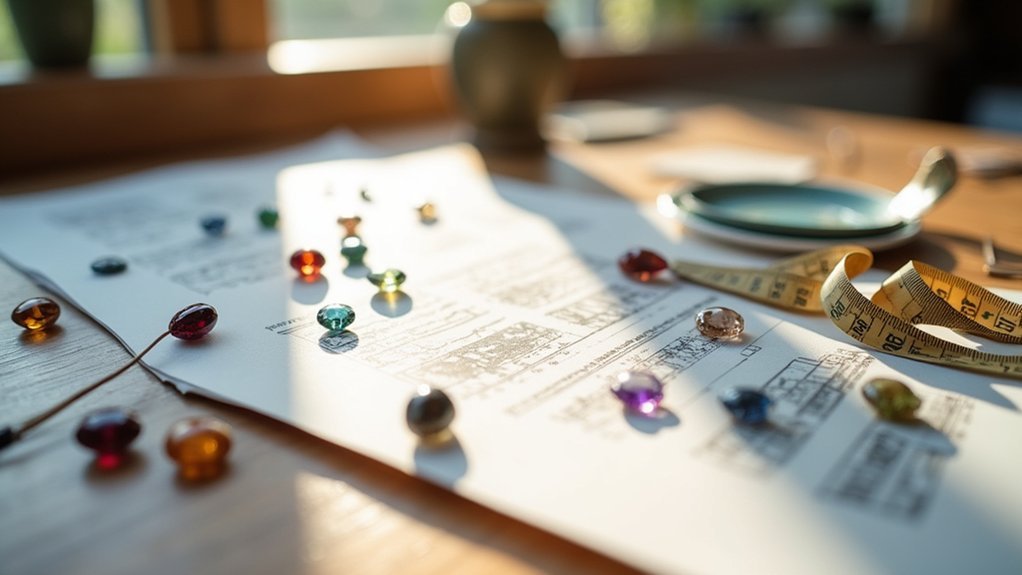
You’ll discover your clients’ true design preferences most effectively when they bring visual references like photos, magazine clippings, or Pinterest boards to your initial consultation.
Ask specific questions about how they live, work, and express themselves—these lifestyle insights reveal which design elements will resonate with their personality and daily routines.
The combination of visual inspiration and targeted questioning creates a foundation for designs that truly reflect who your clients are rather than generic pieces they’ll eventually outgrow.
Visual References Guide Preferences
Three powerful visual tools can transform how you discover your clients’ design preferences and eliminate costly miscommunications.
First, encourage clients to bring images of designs they admire—this gives you immediate insight into their aesthetic preferences and enables personalized recommendations.
Second, create mood boards and design sketches that help clients articulate their vision more clearly while reducing misunderstandings during the jewelry making process.
Third, implement CAD renderings to provide 3D visualizations of custom pieces, allowing clients to grasp complex design concepts effortlessly.
Visual references become even more valuable when you ask about clients’ lifestyles and personalities. These details influence design choices greatly.
Regularly share examples showcasing varying styles and elements to explore their tastes thoroughly, leading to more informed decisions and ultimately more satisfying design outcomes.
Lifestyle Questions Reveal Insights
How does your client spend their typical day, and what role will this jewelry play in their life? These lifestyle questions reveal essential insights that transform your design approach.
When you ask about their work environment, social activities, and daily routines, you’ll discover practical requirements that influence every design decision.
Does your client work in a corporate office requiring understated elegance, or do they prefer bold statement pieces for creative environments? Understanding their customer preferences through activity-based inquiries reveals jewelry needs you might otherwise miss.
A busy parent needs durable, low-maintenance pieces, while a frequent traveler requires versatile designs.
These targeted lifestyle questions help you create pieces that seamlessly integrate into their world, ensuring satisfaction and long-term wear.
Implementing Collaborative Design Approaches
When you implement collaborative design approaches in jewelry creation, you transform the traditional designer-client relationship into a dynamic partnership that enhances satisfaction and creates truly personalized pieces.
This collaborative design method allows clients to actively participate throughout the creative process, fostering ownership and deeper connection to their custom jewelry.
Effective collaborative design requires these essential elements:
- Interactive brainstorming sessions where clients share inspiration and preferences
- CAD renderings and visual aids that improve communication and reduce misinterpretations
- Real-time collaboration platforms like Sibe with live annotations and version control
- Regular updates and check-ins to manage expectations and guarantee timely completion
Utilizing Technology to Enhance Design Communication
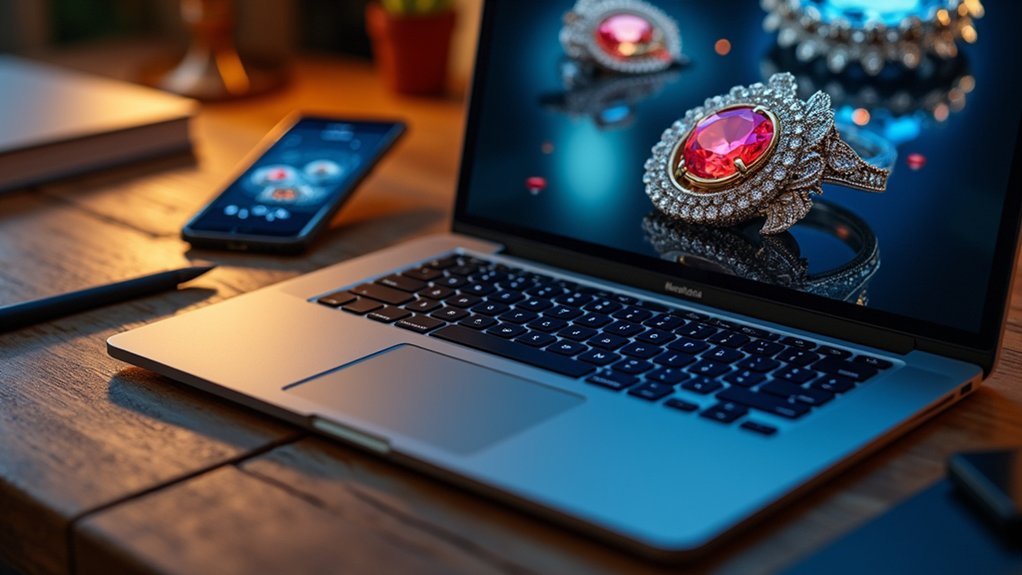
Modern technology revolutionizes how you communicate design concepts to clients, eliminating the guesswork that once plagued custom jewelry creation. You’ll streamline your workflow by implementing platforms like Sibe for real-time collaboration, enabling interactive brainstorming sessions with live annotations on 3D models.
CAD software creates detailed visual representations that help clients visualize your ideas, reducing terminology confusion. Version control keeps everyone aligned on current iterations, while integrated messaging systems facilitate instant feedback throughout the design process.
| Technology Tool | Communication Benefit | Implementation Impact |
|---|---|---|
| Sibe Platform | Real-time collaboration | Interactive brainstorming sessions |
| CAD Software | Visual representation | Reduced misunderstandings |
| Version Control | Design alignment | Minimized confusion |
| Live Chat Systems | Instant feedback | Immediate communication |
| Data Analytics | Pattern identification | Improved client satisfaction |
Data analytics tools identify feedback patterns, helping you tailor communication strategies for enhanced client satisfaction.
Establishing Clear Project Timelines and Milestones
While technology platforms facilitate seamless design communication, your project’s success depends equally on establishing clear timelines that keep everyone aligned from concept to completion.
A well-structured project timeline transforms client communication by setting realistic expectations and preventing misunderstandings. When you define specific milestones upfront, clients understand exactly what happens next and when they’ll see results.
Your milestone-driven approach should include:
Breaking projects into clear milestones with defined deliverables keeps clients informed and ensures steady progress toward completion.
- Initial design sketches – Present concepts within agreed timeframes
- Client approval checkpoints – Schedule dedicated review sessions
- Production phase updates – Communicate manufacturing progress regularly
- Final delivery confirmation – Confirm completion dates early
Regular check-ins at each milestone let you address concerns immediately and make adjustments before advancing.
This structured communication builds trust, keeps clients engaged throughout the process, and guarantees their vision becomes reality without surprises or delays.
Handling Design Revisions and Feedback Professionally
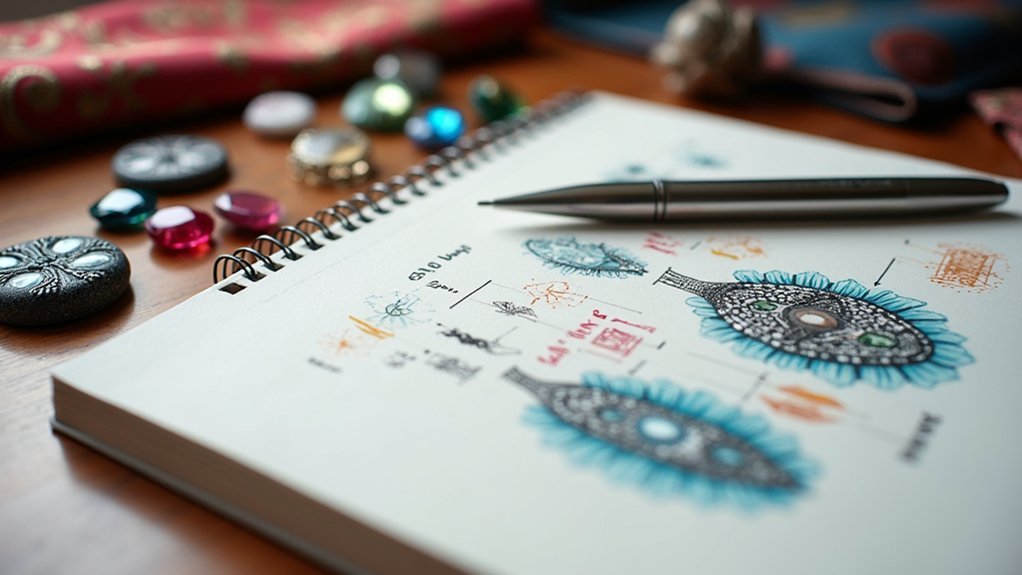
Even with perfectly structured timelines, design revisions become an inevitable part of the jewelry creation process that can either strengthen or strain your client relationships.
You’ll need to establish clear revision parameters from the start, outlining how many changes you’ll include in your initial agreement. This prevents scope creep and manages expectations effectively.
When receiving client feedback, practice active listening by summarizing their comments back to them. This confirms your understanding and shows you value their input.
Visual aids like CAD renderings or detailed sketches help minimize miscommunication during design revisions. Invite clients to participate collaboratively in the revision process, making them feel invested in the outcome.
Set realistic timelines for each revision round and communicate any changes promptly to maintain transparency throughout your design process.
Communicating Material Options and Technical Limitations
After establishing your revision process, you must educate clients about material properties and design constraints to prevent costly misunderstandings later.
When presenting material options to your customer, clearly explain durability differences between metals like platinum versus gold. Use visual aids such as material samples and swatches so clients can experience textures and finishes firsthand.
Discuss technical limitations upfront to manage expectations effectively:
- Detail constraints – Explain how intricate designs may not translate well in certain materials.
- CAD renderings – Show visual demonstrations of how different materials appear in final designs.
- Maintenance requirements – Provide thorough care guides for each material choice.
- Cost implications – Connect material properties to pricing and longevity factors.
This transparency builds trust while ensuring informed decision-making throughout your collaboration.
Maintaining Regular Updates During Production
Once production begins, you’ll need to establish a systematic approach to keeping your clients informed through scheduled progress reports that arrive at predictable intervals.
You should implement visual documentation methods like progress photos and updated renderings that clearly show how their piece is developing at each stage.
Most importantly, you must practice timeline transparency by sharing realistic completion dates and promptly communicating any changes that could affect delivery schedules.
Scheduled Progress Reports
While maintaining open communication throughout the jewelry design process builds essential client relationships, scheduled progress reports transform sporadic updates into systematic touchpoints that keep clients engaged and informed.
These reports foster transparency by providing regular glimpses into your design’s evolution, greatly boosting customer satisfaction through consistent communication.
Establishing weekly or bi-weekly scheduled progress reports creates accountability while demonstrating your commitment to excellence.
Include visual aids like CAD renderings and photos to help clients visualize their piece’s development.
Key milestones for progress reports:
- Initial design approval – Confirm concept direction
- Material sourcing completion – Update on procurement status
- Production phases – Share manufacturing updates
- Quality checkpoints – Document craftsmanship progress
This systematic approach reduces misunderstandings, manages expectations effectively, and keeps clients anxiety-free throughout the entire creation process.
Visual Documentation Methods
Beyond establishing regular reporting schedules, you’ll maximize client engagement by implementing thorough visual documentation methods that bring your jewelry creation process to life. High-resolution images and 3D renderings showcase detailed aspects of each custom piece throughout production stages. Create shared digital folders containing sketches, photos, and production notes for easy client access and tracking.
| Documentation Type | Purpose |
|---|---|
| High-resolution photos | Capture detailed craftsmanship progress |
| 3D renderings | Visualize design concepts clearly |
| Video updates | Showcase evolving creation process |
| Visual timelines | Outline milestones and completion dates |
Regular video updates provide insights into craftsmanship techniques, helping engage customers with deeper connections to their pieces. Schedule virtual meetings to discuss progress and gather feedback, fostering collaborative relationships throughout the design journey.
Timeline Transparency Practices
How can you transform client anxiety into excitement throughout the jewelry creation process? Timeline transparency becomes your most powerful tool for exceptional client communication in jewelry design. When you provide clear timelines for each phase, you’ll manage expectations while reducing client stress about their order’s progress.
Implement these essential timeline transparency practices:
- Send weekly progress updates via email or text messages to maintain connection.
- Use project management tools that allow real-time viewing of design status.
- Establish specific milestone checkpoints for client feedback and approvals.
- Communicate delays immediately with revised timelines and explanations.
This transparency approach builds trust and enhances satisfaction—70% of customers prefer businesses that keep them consistently informed throughout the entire buying process.
Presenting Final Designs With Confidence
When you reach the pivotal moment of presenting final designs, your confidence becomes the bridge between concept and client commitment. Start by recapping your design process and how you’ve integrated their specific preferences, establishing credibility from the outset.
Use high-quality CAD renderings and detailed sketches to showcase intricate details clearly. Include lifestyle imagery showing the piece being worn—this emotional connection drives excitement and purchase decisions.
Structure your presentation flow logically, but don’t just display—engage. Encourage customer feedback throughout to create interactive dialogue and ownership feelings.
Use storytelling techniques to share the inspiration and craftsmanship behind each element. Your narrative transforms technical specifications into meaningful experiences.
When clients understand the “why” behind design choices, they’ll appreciate the artistry and feel confident in their investment decision.
Following Up After Project Completion
Your presentation success doesn’t end when the client says yes and receives their finished piece.
Strategic follow-ups transform one-time buyers into loyal advocates who’ll return for future projects and refer others to your services.
Reach out within a week of delivery to gauge satisfaction and gather feedback. This personalized touch demonstrates your commitment to exceptional client experience and helps identify areas for improvement in your design process.
Implement these follow-up strategies to maximize relationship building:
- Send biannual check-in messages to stay top of mind
- Request photos and experiences for marketing testimonials
- Provide jewelry care and maintenance guidance
- Ask for honest feedback about your design process
Regular communication positions you as a knowledgeable partner invested in their satisfaction long after purchase completion.
Frequently Asked Questions
How to Attract Customers for Jewellery?
You’ll attract jewelry customers by showcasing craftsmanship on Instagram, offering personalized pieces, implementing loyalty programs, using email marketing, and collaborating with influencers to expand reach and build credibility in the market.
How to Improve Customer Communication?
You’ll improve customer communication by establishing multiple contact channels, using visual aids like sketches and renderings, asking open-ended questions about preferences, scheduling regular check-ins, and training staff in active listening techniques.
How to Greet Customers in a Jewelry Store?
You should greet customers with a genuine smile and warm welcome within seconds of their arrival. Make eye contact, offer assistance, and create an inviting atmosphere that makes them feel valued and comfortable immediately.
How Do I Get Customers for My Jewelry Business?
You’ll attract customers by developing targeted buyer personas, building a strong online presence through Instagram and websites, offering customizable jewelry options, using email marketing, and leveraging customer reviews to build trust.
In Summary
You’ll transform your jewelry design practice by mastering these communication techniques. When you actively listen, visualize concepts clearly, and maintain transparent dialogue, you’ll build lasting client relationships that generate repeat business. Don’t underestimate the power of regular updates and confident presentations—they’re what separate exceptional designers from the competition. Start implementing these strategies today, and you’ll see immediate improvements in client satisfaction and project outcomes.

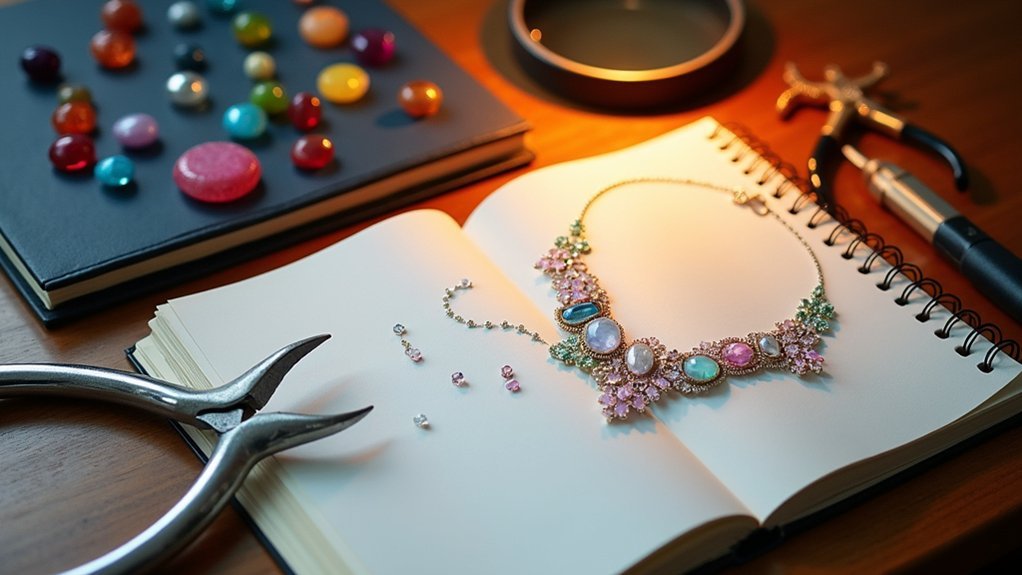
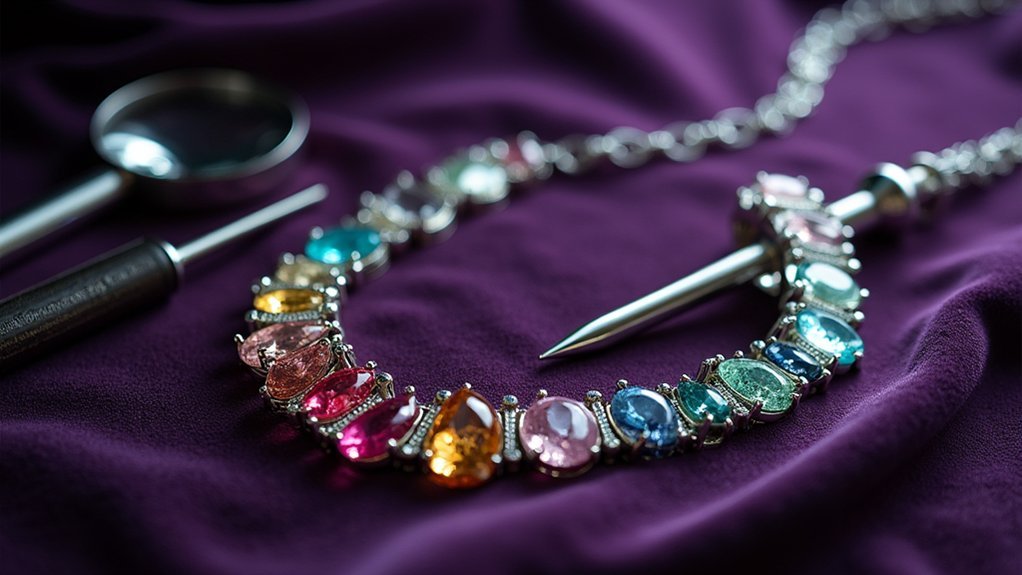

Leave a Reply